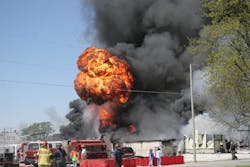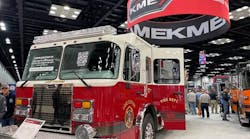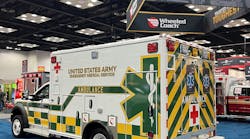On Thursday, April 19, 2012, a five-alarm fire destroyed the R.D. Holder Oil Co. in Pike Township, Clark County, Ohio. Before the fire was extinguished, more than 125 firefighters from 38 departments in Clark, Champaign, Greene, Madison, Miami and Montgomery counties responded. Several containers exploded, forcing firefighters to evacuate and take cover. No-fly-zone and shelter-in-place orders were issued during the incident.
The fire started while a flammable liquid was being transferred from a storage tank to a fuel-delivery truck, then extended to the storage tanks and spread rapidly, engulfing the entire facility.
The fire was considered a National Incident Management System (NIMS) Type 3 incident that involved local, regional and state agencies and lasted more than one operational period (see box on page XX). A total of 54 public and private agencies were involved in firefighting, hazardous materials mitigation, scene safety and support operations.
Construction and contents
R.D. Holder Oil Co. is a distributor of fuel, oil and industrial lubricants. The complex consisted of four interconnected one-story buildings occupying 15,000 square feet. Construction consisted of a cement block building, pole barns and a double-wide trailer used as office space. The buildings were covered with aluminum and sheet metal with metal roofing. They were equipped with a security system, but no fire detection or protection systems. Contents included 40,000 gallons of various grades of motor oils, hydraulic oils and transmission fluids; 10,000 gallons of biodiesel fuel; 1,750 gallons of used oil; 275 gallons of heating oil; 300 gallons of diesel fuel; and 10,300 gallons of lubricants.
The Pike Township Fire Department was dispatched to a reported fuel truck fire at the Holder facility at 10:51 A.M. Responding on the first alarm were Pike Township Engine 1, a 1,250-gpm pumper; Tanker 1, a 1,750-gallon tanker with a 750-gpm pump; Medic 1; and Rescue 1 with seven firefighters under the command of Firefighter/Medic Daniel Carpenter. Automatic mutual aid responding on the initial alarm included German Township Fire Department Engine 2, a 1,500-gpm pumper; New Carlisle Fire Department Quint 2, a 750-gpm pumper with a 100-foot aerial ladder; and Bethel Clark Fire Department Engine 54, a 1,250-gpm pumper and Tanker 54, a 2,000-gallon tanker with a 1,250-gpm pump.
On arrival, Bethel Township 514 Lieutenant Jerry Meddock found a 1,000-gallon fuel delivery tanker fully involved on the C side near the D corner of the building with fire extending into the warehouse. The four-compartment, aluminum tank contained racing fuel. Meddock immediately requested mutual aid from the Wright-Patterson Air Force Base Fire Department, 15 miles from the scene, for its foam capabilities and knowledge of fighting flammable liquid fires.
All 15 employees of the company had evacuated the area before the arrival of the fire department. Pike Township Engine 1 was positioned on side C. Firefighters made an initial attack on the tanker in an effort to stop the extension of the fire into the building. Crews advanced two 200-foot, 1¾-inch attack lines from Engine 1. A 1,000-gallon portable tank was set up alongside Engine 1 for a water supply. This operation was supplied by Pike Township Tanker 1.
After about 30 minutes, firefighting operations at this location were abandoned as the fire continued to spread into the warehouse. The hoselines and portable tank were abandoned and Engine 1 was repositioned to the B side of the complex in an effort to keep the fire from spreading into the next building.
Defensive operations
German Township Truck 1 was positioned on the D side of the building on Detrick Jordan Pike and set up for aerial master stream operations. This unit was supplied by German Township Tanker 1. Bethel Clark Engine 51 and Tanker 54 were also positioned on the D side and set up operations for an attack at the A/D corner of the building. The crew from Engine 51 attempted forcible entry into the building after finding all doors lock on the D side of the warehouse. A master stream was placed into operation on the D side supplied by a 200-foot, three-inch line from Engine 51. A dump-tank operation was established by Tanker 54 and Engine 51.
At 11:14 A.M., the Wright-Patterson Air Force Base Fire Department responded with Crash 17, a crash-fire-rescue vehicle carrying 1,700 gallons of foam; Tanker 8, a 3,500-gallon tanker; and Tanker 12, a 5,000-gallon tanker with six firefighters and Fire Chief Jacob King, who assumed command on arrival. Pike Township Fire Chief Jerry Donnelly took the position of deputy incident commander. Lieutenant Robbie Oldham from German Township was assigned as operations chief. Pike Township Chief 2 Dave Richardson was assigned as deputy operations chief. Wright-Patterson Safety Officer Jeffery Kitzmiller was assigned as the incident safety officer. Captain J.R. Routt from the Enon Fire Department was assigned as water supply officer. The initial command post was established on side B.
More resources called
As the fire continued to spread, additional resources were requested. Due to the rural setting, no nearby water supplies were available. Engines and tankers responded from the Covington, Fletcher, Harmony Township, Hustead, Jasper/St. Paris, Ludlow Falls, Mad River/Enon, Madison, Moorefield, New Carlisle, Pitchin, Pleasant Township, Pleasant Hill, Rosewood, Tipp City/Monroe, Urbana and West Milton fire departments.
Initially, tankers drew water from the North Hampton water system, which became depleted. Tankers were then redirected to the Northwestern School District water system, which also became depleted, causing the tankers to be directed to hydrants at the Upper Valley Mall that are supplied by the City of Springfield water system. A water supply was also established at Chateau Estates and a pond at Evans Farm. No further water-supply issues developed. A total of 32 tankers supplied six portable tanks at the scene.
At 12:14 P.M., King requested a no-fly zone around the incident after observing several small aircraft and two news helicopters flying very low over the scene. This was to keep aircraft from approaching the scene to ensure the safety of any aircraft personnel and to keep the hazard plume from changing wind direction. The Federal Aviation Administration (FAA) ordered a 1,000-foot no-fly zone around the incident.
Containers explode
The first of several BLEVEs (boiling liquid expanding vapor explosions) of containers occurred at 12:14 P.M. Firefighting crews were ordered to evacuate the area and take cover. A personnel accountability report (PAR) was conducted and all personnel on scene were accounted for. Once the BLEVEs subsided, the defensive attack was initiated from the B side using foam.
The Clark County Sherriff's Office made a mass notification of a shelter-in-place order for a one-mile radius at 12:54 P.M. using the reverse 911 system. There were 124 residences in the area affected by the order. The Northwestern School District was notified of the road closures and to shelter the students in place. Early dismissal of students was arranged with the high school dismissed at 1:30 P.M. and the elementary school at 2:30 P.M. All evening activities at the schools were canceled.
Ongoing operations
Box 27 arrived on scene and set up a rehabilitation area for firefighters to be mandatorily rotated in and out of. Pike Township Medic 1 provided medical support and firefighter monitoring. The Clark County Engineering Office provided diesel fuel to refuel apparatus that were getting low on fuel due to operating on scene for an extended period.
All firefighting operations were defensive in nature. Apparatus had to be repositioned several times on the D side due to weather, heat and smoke conditions. Section chiefs were assigned to the B and D sides. Oldham was assigned to D side and Kitzmiller was assigned to B side. Lieutenant Trent Zerkle from the Christianburg Fire Department was assigned as the tanker staging officer to control tanker movement and to assist the water supply officer. This ensured that the tanker-shuttle operations ran smoothly and that there were no water supply issues on the fireground.
Environmental issues
The Clark County Hazardous Materials Team arrived on scene and assigned City of Springfield Lieutenant Brian Wirth as accountability officer and Springfield Chief 2 Brian Miller as hazmat branch chief. The hazmat team requested the damming and diking trailer from Enon to respond to the scene. It was decided to construct an underflow dam at the southwest corner of the property near the creek to ensure contaminants were captured close to the incident. Additionally, the team placed absorbent pads and booms to collect the contaminated runoff. The Clark County Engineering Office provided an excavator, three dump trucks and five loads of dirt and gravel along with equipment operators to help mitigate the hazardous materials spills and runoff. The Clark County Combined Health District (CCCHD) provided support and coordination for researching and monitoring toxins and air quality,
At 2 P.M., the Ohio Fire Chiefs Emergency Response Plan (OFCERP) was activated to provide fill-in coverage for eight departments in Clark County that had completely depleted their resources. Manpower and apparatus from Fairborn, Huber Heights, Miami Township, Silver Creek, Spring Valley, Sugar Creek Township, Xenia City and Xenia Township provided coverage.
King declared the fire under control at 4:54 P.M. The no-fly zone was canceled at 4:55, the shelter-in-place order was lifted at 5:04 and the OFCERP was canceled at 6 P.M. Collapsed building debris covered many hot spots, preventing crews from extinguishing them. Pike Township Public Works supplied a backhoe that was used on side D to remove debris and a trackhoe from Clark County removed debris on side B. These efforts let firefighters access the hot spots. Mutual aid units began being released at 6:17 P.M. The last Pike Township units left the scene at 1:16 P.M. on April, 20.
Conclusion
One hundred twenty five firefighters used 3.5 million gallons of water and 1,600 gallons of foam to extinguish the fire. Damage was estimated at $2 million to the building and $900,000 to the contents. Weather conditions at the time of the fire were sunny with the temperature at about 70 degrees and 5-mph winds. One firefighter was injured. No civilians were injured. More than 5,600 fish and other animals died as a result of contamination in an unnamed tributary of Donnels Creek.
It was determined that a static discharge during the transfer of a flammable liquid from a storage tank to the fuel truck ignited the fire. The fire progressed from the fuel delivery truck back inside the building to the storage tanks on the C side of the building. The fire spread rapidly, engulfing the entire facility.
PIKE TOWNSHIP FIRE DEPARTMENT
Chief: Jerry Donnelly
Personnel: 40 volunteer firefighters
Apparatus: 2 pumpers, 2 tankers, 1 rescue, 1 grass truck, 1 ALS unit
Population: 3,891
Area: 37 square miles






